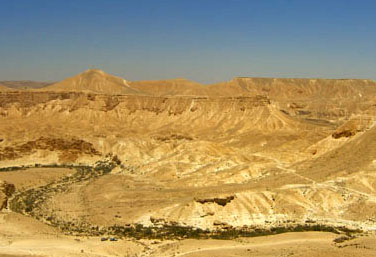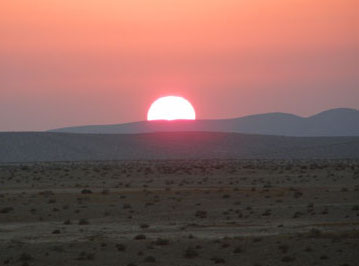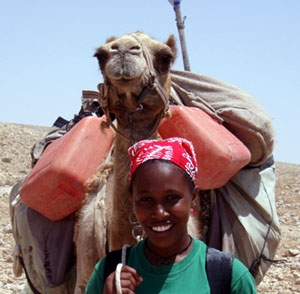By Yael Ukeles
Have you ever tried to map out the Jewish People’s first long trek as a nation- from Egypt to Sinai?
It’s a tough job. Our ancestors circled and detoured- even went backwards- en route to their ultimate goal of Eretz Yisrael.
First we avoided Derech Eretz Plishtim, to stray from the easy way back to Egypt. Then, as described in Parshat Maasei, we went out of our way to cross the sea. After leaving the sea- we made a semicircle right on back again! The Rabbis in Gemara Erchin (15: A) were surprised by the same phenomenon: Why did we go backwards?
Furthermore, why walk in the first place? Why should God not have picked us up and placed us directly in Israel? Why make us wander?
 I would like to offer one possible explanation: In between our leaving Egypt and receiving the Torah, Hashem took us on a prolonged walk through the wilderness to teach us two important lessons before we would build a new civilization in Israel:
I would like to offer one possible explanation: In between our leaving Egypt and receiving the Torah, Hashem took us on a prolonged walk through the wilderness to teach us two important lessons before we would build a new civilization in Israel:
One, even in the midst of creating a society, it is imperative to journey in Nature and be inspired.
And two, despite having a goal to achieve, life is first and foremost a journey and a process.
But how does Nature inspire us? And what have we to benefit from a journey? What is the value in a process?
In Shemot, Chapter 15, the Jewish People “Walked three days in the desert and did not find water.” The Ishbitzer Rebbe explains that after the miracles of Mitzrayim and Yam Suf, “they didn’t find any yearning and desire. Their enthusiasm became greatly diminished.” “No water” meant that we found no inspiration to give us life.
The text continues as ”God showed him (Moshe) a tree.” According to the Ishbitzer, God’s giving of an Etz- a tree- is His giving Etzah, advice. Hashem taught that embedded in the monotone of everyday life are hidden miracles; hidden truths that complement the spectacular.
By experiencing Kriyat Yam Suf, we witnessed the awesome power of Hashem. By walking through the desert, we learned to find Him amidst the quiet. Nature teaches us to appreciate the world’s grandeur- and its subtleties.
The Netivot Shalom, quoting the Baal Shem Tov takes the story of our travels through the desert one step further:
Parshat Maasei includes 42 stops from Egypt to Israel. Says the Baal Shem Tov: Not only did the generation that left Egypt have 42 journeys, but each one of us has 42 journeys to complete in our own lives, as well. The Baal Shem teaches that life’s deepest secrets are revealed through our own personal journeys.
We live in a goal-focused society: final exams, graduation, the end of the day, the end of the week, vacation time, retirement- in short, getting there.
 Being goal-oriented is, of course, a good thing; as a backpacker, I know very well the ache to get to the top and appreciate the view. But investing in a journey makes the goal worth it. Even without ever achieving the goal, the value of a journey stands on its own. As Robert Hastings writes, “The joy of life is in the trip…Life must be lived as we go along.”
Being goal-oriented is, of course, a good thing; as a backpacker, I know very well the ache to get to the top and appreciate the view. But investing in a journey makes the goal worth it. Even without ever achieving the goal, the value of a journey stands on its own. As Robert Hastings writes, “The joy of life is in the trip…Life must be lived as we go along.”
I remember hiking with a participant on Derech Hateva’s Israel Trail Teen Adventure, as we climbed up the Galilee’s Mount Meiron. Besides the trail there is a road to the mountain top. The participant looked dreamily at the cars and asked, “Why can’t we just drive up the mountain?”
I listened patiently, anticipating the feeling she would have once we reached the top. Sure enough, we got there and she realized: The view from the top of a mountain is so much more special, when that view has been earned through effort.
And so, instead of picking us up out of Egypt and placing us in Israel, even instead of giving us a direct route to Israel, God gives us a trail into the sea and the desert, past Nature’s grandeur and through its quiet, so as to teach us not to rush towards our goal. We are to take it slow, to stray now and then from the route and be inspired by the way there.
“Rise up. Walk the Land through its length and breadth,” Hashem tells Avraham (Bereishit 13:17), “For I will give it to you.” The first thing for Avraham to do upon being promised Israel, is not to start building a house or a village. Avraham is to take a nice, long hike around Israel.” According to the Kli Yakar, Avraham’s looking out to the land- “Yamah V’Kedmah, Tzafonah V’Negbah”- expresses his spiritual connection to Israel. His walking the land fosters his physical connection with her.
Like our forefathers before us, we are to walk and engage with our Land. By seeing it and walking its length and its breadth, we uncover beauty after beauty, secret after secret. Our relationship with Israel becomes real, the Land, truly ours.
This Pesach, may we leave Egypt as free people: redeemed to journey towards our goals, and never to be enslaved by them. Chag Kasher V’Sameach!
 On Derech Hateva, we are not the first to trek through the Land- our ancestors have been doing it for years. And, we hike and explore with the same spirit of wonder, awe, excitement and inspiration that accompanied our nation from day one.
On Derech Hateva, we are not the first to trek through the Land- our ancestors have been doing it for years. And, we hike and explore with the same spirit of wonder, awe, excitement and inspiration that accompanied our nation from day one.
Contact us and join the adventure!
Featured in Pesach 5768 issue of the Shiur Times
Special thank you to Yannai Kranzler for editorial assistance.
|
|

